|
DEFENDING THE PICK-AND-ROLL OFFENSE
In recent years, due in part to the style of play in the
NBA and overseas in Europe, the pick-and-roll offense has become a
popular offense in basketball. The defense is difficult to stop
because of how well the ball-handlers can play off of the ball screen.
The purpose of this article is to give coaches some ideas on how to
guard ball screens and how to make adjustments based on the skills of
the players receiving these on-ball screens.
Defending the Pick and Roll
In breaking down the ways that the pick-and-roll defenses are presented, we will
group the defenses by the way in which the on-ball defender. The first of
these is what we call "Under" maneuvers. Here, the on-ball defender will
go under the screen because the ball-handler is either an effective driver or
he is not a very good perimeter shooter.
Diagrams 1 and 2 show variations of "Under" maneuvers. Diagram 1 shows the
straight under maneuver. Here, while the on-ball defender goes under the
screen, the screener's defender bumps the screener with his chest and keeps his
hands up so as to show the referees that he is not pushing with his hands.
Diagram 2 has the screener's defender show on the pick-and-roll. This is
used when the ball-handler is not a good shooter. We have the screener's
defender show three quarters of his body to for the ball up the floor and away
from the basket. Once the on-ball defender is able to match-up, the
screener's defender finds the screener and gets ready to guard him.
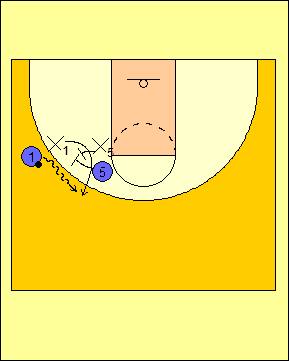
Diagram 1 |
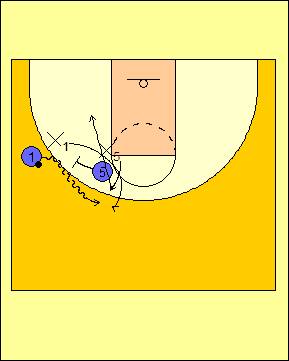
Diagram 2 |
The second set of maneuvers illustrated in Diagrams 3 and 4 are called
"Over" maneuvers. Here, we are playing against someone who can shoot
exceptionally well off of the ball screen and we want to take the shot away.
Again, like that of the "Under" maneuvers, we can have the screener's defender
either not show (Diagram 3) or show (Diagram 4). When the defender does
not show on an "Over" maneuver, he drops into the lane.
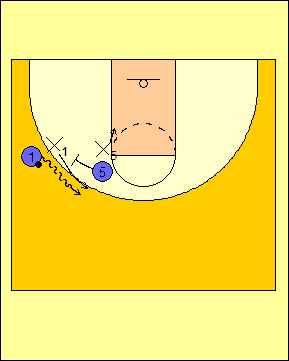
Diagram 3 |
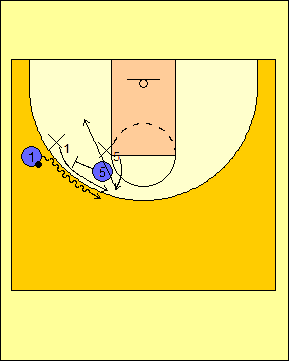
Diagram 4 |
The third set of maneuvers by the on-ball defender are what are called
miscellaneous. This is because these moves do not necessarily fall under
the "under" or "over" maneuvers. Diagram 5 is a trap of the ball-handler
off of the pick-and-roll with X1 and X5 setting the trap off of the ball screen.
Meanwhile, Diagram 6 is a defensive switch. If we are at the end of the
clock or if the players involved in the pick-and-roll have similar offensive
skill sets, we will switch the ball screen.
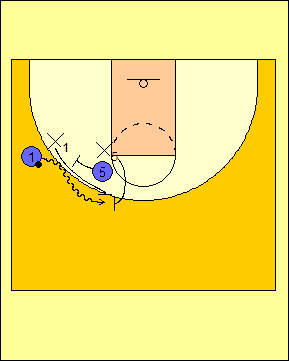
Diagram 5 |
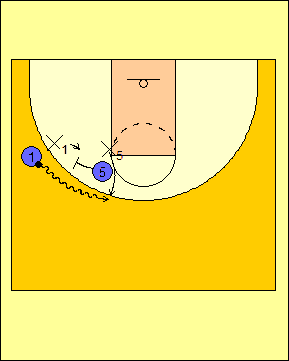
Diagram 6 |
The last maneuver by the defense is what we call
"Block". Here, we will have the on-ball defender block the
path to the ball screen and have the would-be ball screener's man
drop off into the lane (Diagram 7). This will prevent the ball
screen from taking place and is effective against players who can
shoot or drive equally well off of a ball screen.

Diagram 7 |
Another popular ball screen that is being run is the
post screening the on-ball defender from behind when the ball is in
the middle of the floor. This pick-and-roll play has been used
extensively by teams like Louisville and Florida on the college
level. When we defend this type of maneuver as shown in
Diagram 8, it is the responsibility of the screener's defender to
call out which way he wants the ball to go ("right" or "left").
|
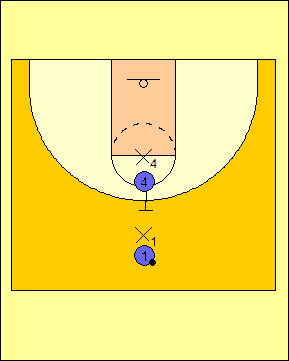
Diagram 8 |
Conclusions
The way in which the ball screen is defended is up to
the defensive coach's decision and the scouting report. As with
any offensive maneuver, it is important to take away from offensive
players what they do best and, if possible, force them to do things they
do not normally do well. It is also important that the defensive
players communicate effectively and that communication should be early,
loud, and continuous.
RETURN TO MEMBERSHIP AREA
© 2010-2017 Alan Peel Enterprises
|